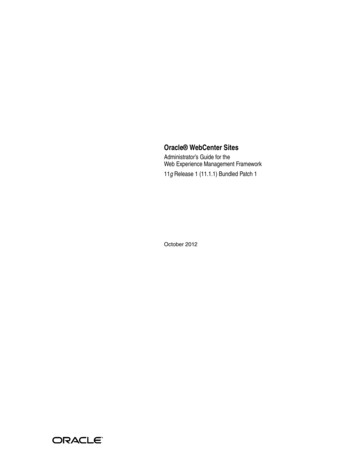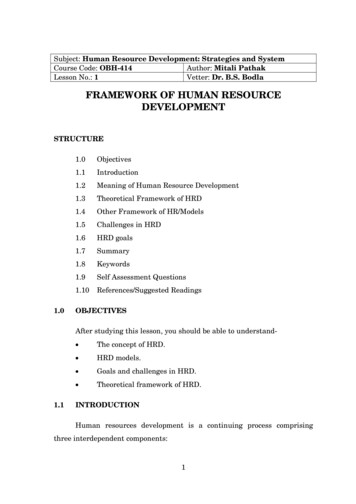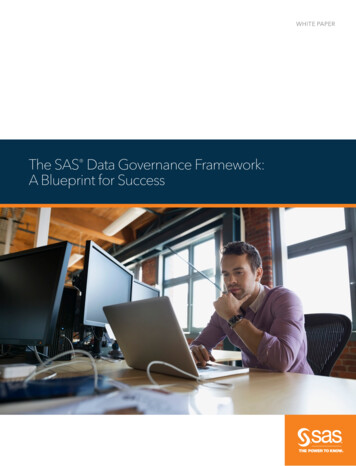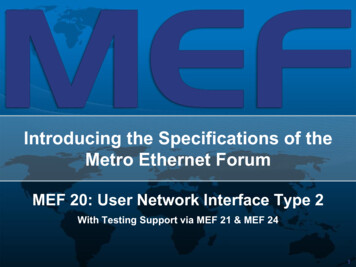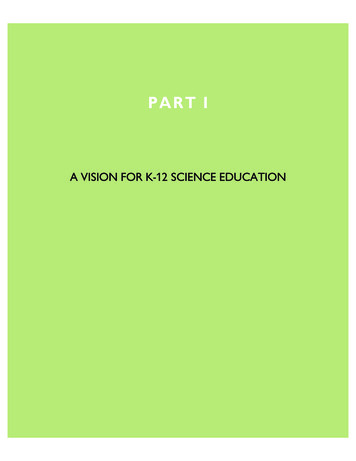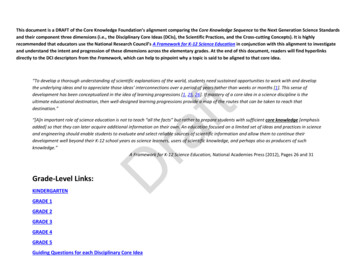
Transcription
This document is a DRAFT of the Core Knowledge Foundation’s alignment comparing the Core Knowledge Sequence to the Next Generation Science Standardsand their component three dimensions (i.e., the Disciplinary Core Ideas (DCIs), the Scientific Practices, and the Cross-cutting Concepts). It is highlyrecommended that educators use the National Research Council’s A Framework for K-12 Science Education in conjunction with this alignment to investigateand understand the intent and progression of these dimensions across the elementary grades. At the end of this document, readers will find hyperlinksdirectly to the DCI descriptors from the Framework, which can help to pinpoint why a topic is said to be aligned to that core idea.t“To develop a thorough understanding of scientific explanations of the world, students need sustained opportunities to work with and developthe underlying ideas and to appreciate those ideas’ interconnections over a period of years rather than weeks or months [1]. This sense ofdevelopment has been conceptualized in the idea of learning progressions [1, 25, 26]. If mastery of a core idea in a science discipline is theultimate educational destination, then well-designed learning progressions provide a map of the routes that can be taken to reach thatdestination.”Draf“[A]n important role of science education is not to teach “all the facts” but rather to prepare students with sufficient core knowledge [emphasisadded] so that they can later acquire additional information on their own. An education focused on a limited set of ideas and practices in scienceand engineering should enable students to evaluate and select reliable sources of scientific information and allow them to continue theirdevelopment well beyond their K-12 school years as science learners, users of scientific knowledge, and perhaps also as producers of suchknowledge.”A Framework for K-12 Science Education, National Academies Press (2012), Pages 26 and 31Grade-Level Links:KINDERGARTENGRADE 1GRADE 2GRADE 3GRADE 4GRADE 5Guiding Questions for each Disciplinary Core Idea
Grade 4KindergartenCore Knowledge Sequence:Science Content GuidelinesAlignedDisciplinaryCore Ideas(DCIs)1Next Generation Science Standards:Opportunities for integration :PracticesConceptsat grade levelbelow or above grade levelI. Plants and Plant GrowthCKLA Listening & LearningDOMAIN #4 - "Plants" Plants make their ownfood. Flowers and seeds: seedsas food for plants andanimals (for example, rice,nuts, wheat, corn) Two kinds of plants:deciduous and evergreenGrade-level LinksLS1.C. Alsocontributesto LS2.A,LS2.B,PS3.D, &ESS2.ELS1.A, LS1.C,& LS2.A.May alsocontributeto ESS2.EPatternsLS1.A.Opportunityto connect/foreshadowLS1.B. May K-LS1-1. Use observations todescribe patterns of whatplants and animals (includinghumans) need to survive.tAnalyzing andInterpretingDataraf Basic parts of plants: seed,root, stem, branch, leafLS1.C. Alsocontributesto LS2.A,ESS2.E, &ESS3.ALS1.A. Alsocontributesto LS3.A &LS3.BEngaging inArgument fromEvidenceSystems &System ModelsD What plants need togrow: sufficient warmth,light, and waterDeveloping andUsing ModelsPatternsK-ESS2-2. Construct anargument supported byevidence for how plants andanimals (including humans)can change the environmentto meet their needs.Opportunity for application:K-ESS3-1. Use a model torepresent the relationshipbetween the needs ofdifferent plants and Gap &/or Opportunity2AnalysisOpportunities to foreshadowfuture learning: 1-LS3-1.Make observations toconstruct an evidence-basedaccount that young plants andanimals are like, but notexactly like, their parents.AND 1-LS1-1.Use materials todesign a solution to a humanproblem by mimicking howplants and/or animals usetheir external parts to helpthem survive, grow, and meettheir needs.*DRAFT – Copyright 2014 Core Knowledge Foundation. All Rights Reserved.The Kindergarten study ofPlants, Animals, and TheHuman Body can be usedtogether as an opportunityto meet the expectationsset forth by the NGSSKindergarten Topic ofInterdependentRelationships inEcosystems. Particularly,the content guideline ofFarming and its associatedsub-guidelines can be usedto investigate how humansand other animals interactwith their environment tosurvive.2
KindergartenCore Knowledge Sequence:Science Content GuidelinesAlignedDisciplinaryCore Ideas(DCIs)1Next Generation Science Standards:Opportunities for integration :Practicesalso beapplied toLS2.A &ESS3.AConceptsat grade levelGap &/or Opportunity2Analysisbelow or above grade levelanimals (including humans)and the places they live.Systems &System ModelsCKLA Listening & LearningDOMAIN #5 - "Farms"How farmers must takespecial care to protect theircrops from weeds and pestsContributesto LS2.A.May also beapplied toESS2.E,ESS3.Cand/orETS1.BAskingQuestions andDefiningProblemsHow crops are harvested,kept fresh, packaged, andtransported for people to ESS3.A &ETS2.BDeveloping andUsing ModelsGrade-level LinksCause and EffectK-ESS3-3. Communicatesolutions that will reduce theimpact of humans on theland, water, air, and/orother living things in thelocal environment.*tLS1.C &ESS3.AObtaining,Evaluating, andCommunicatingInformationSystems &System ModelsrafHow some food comesfrom farms as cropsDeveloping andUsing ModelsK-ESS3-1. Use a model torepresent the relationshipbetween the needs ofdifferent plants and animals(including humans) and theplaces they live.D FarmingESS3.A.May also beapplied toESS2.E,ESS3.C &ETS2.BStructure andFunctionThe study of "how farmerstake special care to protectcrops" is also a significantopportunity to beginaddressing the K-2Engineering Designstandards such as K-2-ETS11. Ask questions, makeobservations, and gatherinformation about asituation people want tochange to define a simpleproblem that can be solvedthrough the development ofa new or improved object ortool.Opportunities for applicationwith engineering design: K2-ETS1-1, -2 and/or -3DRAFT – Copyright 2014 Core Knowledge Foundation. All Rights Reserved.3
KindergartenCore Knowledge Sequence:Science Content GuidelinesAlignedDisciplinaryCore Ideas(DCIs)buy and consume1Next Generation Science Standards:Opportunities for integration :PracticesConceptsat grade levelPatternsK-LS1-1. Use observations todescribe patterns of whatplants and animals (includinghumans) need to survive.Gap &/or Opportunity2Analysisbelow or above grade levelAnalyzing andInterpretingDataII. Animals and Their Needs Plants make their ownfood, but animals get foodfrom eating plants or otherliving things.LS1.C. Alsocontributesto LS2.A,LS2.B,PS3.D,ESS2.E, &ESS3.C Offspring are very much(but not exactly) like theirparents.LS3.A &LS3.B.Also appliesLS1.A. Most animal babies needto be fed and cared for bytheir parents; human babiesare especially in need ofcare when young.LS1.B Pets have special needsand must be cared for bytheir owners.LS1.BGrade-level LinksAnalyzing andInterpretingDatarafLS1.C. Alsocontributesto LS2.A,ESS2.E, &ESS3.AEngaging inArgument fromEvidenceSystems &System ModelsK-ESS2-2. Construct anargument supported byevidence for how plants andanimals (including humans)can change the environmentto meet their needs.1-LS3-1. Make observationsto construct an evidencebased account that youngplants and animals are like,but not exactly like, theirparents.D Animals, like plants, needfood, water, and space tolive and grow.tCKLA Listening & LearningDOMAIN #5 - "Farms"ConstructingExplanations &DesigningSolutionsDeveloping andUsing ModelsPatternsSystems &System ModelsOpportunity for application:K-ESS3-1. Use a model torepresent the relationshipbetween the needs ofdifferent plants and animals(including humans) and theplaces they live.1-LS1-2. Read texts and usemedia to determine patternsin behavior of parents andoffspring that help offspringsurvive.DRAFT – Copyright 2014 Core Knowledge Foundation. All Rights Reserved.Kindergarten teachers mayalso find it beneficial towork with Grade 1 teachersre: the future studies ofHabitats as they work toprepare students for KESS3-1.4
KindergartenCore Knowledge Sequence:Science Content GuidelinesAlignedDisciplinaryCore Ideas(DCIs)1Next Generation Science Standards:Opportunities for integration :PracticesConceptsat grade levelbelow or above grade levelIII. The Human BodySmell: noseTaste: tongueTouch: skin Taking care of your body:exercise, cleanliness,healthy foods, restLS1.A &LS1.DLS1.A &LS1.DStructure &FunctionStructure &FunctiontHearing: earsConstructingExplanationsand DesigningSolutionsConstructingExplanationsand DesigningSolutionsThe study of the Five Sensesdirectly supports theprogression of theDisciplinary Core Ideas ofLS1.D (InformationProcessing) and PS4.C(Information Technologies &Instrumentation) which arefound in grades 1, 4, and MSof the NGSS.Opportunities forapplication: (reviewstandards associated withthe Plants & AnimalsDomains; for example KESS2-2 & K-ESS3-1)1-LS1-1. Use materials todesign a solution to a humanproblem by mimicking howplants and/or animals usetheir external parts to help them survive, grow, and meettheir needs.*rafSight: eyesLS1.A,LS1.D, &PS4.C. Maybe appliedto LS3.BLS1.A,LS1.D, &PS4.CLS1.A,LS1.D, &PS4.CEngaging inArgument fromEvidenceLS1.A,LS1.D, &PS4.CDeveloping andUsing ModelsOpportunityto connectLS1.B and/orETS2.BAnalyzing andInterpretingDataInfluence of Sci.,Eng. and Tech.on SocietySystems &System ModelsDCKLA Listening & LearningDOMAIN #2 - "The FiveSenses" The five senses andassociated body parts:PatternsThe opportunities at leftrelate to addressing K-ESS2-2and K-ESS3-1 as notedabove.K-LS1-1. Use observations todescribe patterns of whatplants and animals (includinghumans) need to survive.IV. Introduction toMagnetismGrade-level LinksGap &/or Opportunity2AnalysisThere is a significantopportunity to use DRAFT – Copyright 2014 Core Knowledge Foundation. All Rights Reserved.5
KindergartenCore Knowledge Sequence:Science Content GuidelinesAlignedDisciplinaryCore Ideas(DCIs) Identify familiar everydayuses of magnets (forexample, in toys, in cabinetlocks, in “refrigeratormagnets,” etc.).PS1.A.Alsosupportslater studyof PS2.B1Next Generation Science Standards:Opportunities for integration :PracticesConceptsat grade levelPlanning andCarrying OutInvestigationsOpportunities for application& extension: K-PS2-1. Planand conduct an investigationto compare the effects ofdifferent strengths ordifferent directions ofpushes and pulls on themotion of an object.below or above grade levelOpportunity to foreshadowfuture learning: 2-PS1-2.Analyze data obtained fromtesting different materials todetermine which materialshave the properties that arebest suited for an intendedpurpose.*tOpportunityto connectto ETS2.ArafCause and Effect Classify materialsaccording to whether theyare or are not attracted by amagnet.K-PS2-2. Analyze data todetermine if a designsolution works as intendedto change the speed ordirection of an object with apush or a pull.*Analyzing andInterpretingDataDPS1.A. Alsosupportslater studyof PS2.BPlanning andCarrying OutInvestigationsGap &/or Opportunity2Analysis2-PS1-1. Plan and conduct aninvestigation to describe andclassify different kinds ofmaterials by their observableproperties.Patternsmagnets and magnetism asthe beginning guidepost forintroducing Pushes and Pullsto kindergarteners relativeto the Disciplinary CoreIdeas of PS2.A and PS3.C. Itis important, however, torecognize and plan for theAssessment Boundarydefined by the NGSSstandard of K-PS2-1, whichstates "Assessment [will not]include non-contact pushesor pulls such as thoseproduced by magnets." It ishighly recommended thatteachers continue tointroduce magnetism inKindergarten relative toeveryday uses and forclassification. The skills ofpattern identification andclassification directlysupport standards in theCommon Core Mathexpectations as well as laterstudies of classification /categorization of materialsand organisms.V. Seasons and WeatherCKLA Listening & LearningDOMAIN #8 - "Seasons &Weather"Grade-level LinksDRAFT – Copyright 2014 Core Knowledge Foundation. All Rights Reserved.6
Kindergarten The sun: source of lightand warmth Daily weather changes –Temperature:thermometers are used tomeasure temperatureESS1.B &ESS2.DESS1.A. Alsodirectlysupportslater studyof ideas suchas LS2.B &PS3.B.PS1.A,ESS2.D, &ETS2.AESS2.C &ESS2.DGrade-level LinksPracticesConceptsat grade levelPatternsK-ESS2-1. Use and shareobservations of localweather conditions todescribe patterns over time.Analyzing andInterpretingDataGap &/or Opportunity2Analysisbelow or above grade level1-ESS1-2. Make observationsat different times of year torelate the amount of daylightto the time of year.Planning andCarrying OutInvestigationsCause and EffectK-PS3-1. Make observationsto determine the effect ofsunlight on Earth’s surface.ESS2.DCloudsRainfall: how thecondition of the groundvaries with rainfall;rainbowsNext Generation Science Standards:t Characteristic localweather patterns during thedifferent seasonsESS1.B.May also beconnectedto thebeginningsof ESS1.C"Someevents onEarth occurin cycles."1Opportunities for integration :raf The four seasonsAlignedDisciplinaryCore Ideas(DCIs)DCore Knowledge Sequence:Science Content GuidelinesESS2.C &ESS2.DConstructingExplanationsand DesigningSolutionsObtaining,Evaluating, andCommunicatingInformationAskingQuestions andDefiningProblemsCause and EffectPatternsCause and EffectOpportunity for application:K-PS3-2.Use tools andmaterials provided to designand build a structure thatwill reduce the warmingeffect of sunlight on Earth’ssurface.*K-ESS3-2. Ask questions toobtain information aboutthe purpose of weatherforecasting to prepare for,2-ESS2-3. Obtain informationto identify where water isfound on Earth and that it canbe solid or liquid.DRAFT – Copyright 2014 Core Knowledge Foundation. All Rights Reserved.7
KindergartenThunderstorms: lightningand thunder, hail, safetyduring thunderstormsSnow and snowflakes,blizzardAlignedDisciplinaryCore Ideas(DCIs)PracticesConceptsat grade levelGap &/or Opportunity2Analysisbelow or above grade leveland respond to, severeweather.*Influence ofEng., Tech., &Sci. on Societyand the NaturalWorldrafObtaining,Evaluating, andCommunicatingInformationInterdependenceof Science,Engineering,and TechnologyDVI. Taking Care of the EarthGrade-level LinksNext Generation Science Standards:ESS3.BESS2.C &ESS2.D. Mayalso beapplied toESS3.B.CKLA Listening & LearningDOMAIN #11 - "Taking Careof the Earth" Conservation: Somenatural resources arelimited, so people must becareful not to use too muchof them (example: loggingand reforestation). Practical measures forconserving energy andresources (for example,turning off unnecessarylights, tightly turning offfaucets, etc.)1Opportunities for integration :tCore Knowledge Sequence:Science Content GuidelinesESS3.A &ESS3.CObtaining,Evaluating, andCommunicatingInformationESS3.CCause & EffectK-ESS3-3. Communicatesolutions that will reduce theimpact of humans on theland, water, air, and/orother living things in thelocal environment.*DRAFT – Copyright 2014 Core Knowledge Foundation. All Rights Reserved.8
Kindergarten Pollution (for example,littering, smog, waterpollution) can be harmful,but if people are carefulthey can help reducepollution.Next Generation Science Standards:Conceptsat grade levelEnergy & MatterESS2.E &ESS3.CSystems &System ModelsOpportunities to extend/connect previous learning:(review standards associatedwith the Plants & AnimalsDomains; for example KESS2-2 & K-ESS3-1)Gap &/or Opportunity2Analysisbelow or above grade levelOpportunity to foreshadowfuture learning: 2-PS1-3.Make observations toconstruct an evidence-basedaccount of how an objectmade of a small set of piecescan be disassembled andmade into a new object.Opportunities forapplication:Opportunityto connectETS1.A,ETS1.B,and/orETS2.BJane Goodall (studiedchimpanzees)Opportunityto connectLS2.Dand/orETS2.BPlanning andCarrying OutInvestigationsEngaging inArgument fromEvidenceCause & EffectOpportunityto iew the standardsassociated with the PlantsDomain above)Cause & Effect(review the standardsassociated with the AnimalsDomain above)Cause & EffectK-2-ETS1-1, 2 & 3; K-PS2-1 &2DGeorge Washington Carver(botanist/discovered waysto keep soil rich)Grade-level LinksPracticesPS1.A &ESS3.AVII. Science BiographiesWilbur and Orville Wright(made first airplane)1Opportunities for integration :t Some materials can berecycled (for example,aluminum, glass, paper).AlignedDisciplinaryCore Ideas(DCIs)rafCore Knowledge Sequence:Science Content GuidelinesOpportunity to foreshadowfuture learning: 3-LS2-1.Construct an argument thatsome animals form groupsthat help members survive.Planning andCarrying OutInvestigationsAnalyzing andInterpretingDataDRAFT – Copyright 2014 Core Knowledge Foundation. All Rights Reserved.9
GRADE 1Core Knowledge Sequence:Science Content GuidelinesAlignedDisciplinaryCore Ideas(DCIs)1Next Generation Science Standards:Opportunities for integration :PracticesConceptsat grade levelGap &/or Opportunity2Analysisbelow or above grade levelI. Living Things and TheirEnvironmentsCKLA Listening & LearningDOMAIN #8 - "Animals &Habitats"A. HABITATSESS3.A,LS2.A, &LS4.C The food chain: a way ofpicturing the relationshipsbetween living thingsAnimals: big animals eatlittle ones, big animals dieand are eaten by little ones.LS4.D. Mayalso connectto LS4.CSystems andSystem ModelsLS4.D. Mayalso connectto LS4.C &ESS2.CLS2.B. Alsosupportsfuture studyof PS3.DConstructingExplanations andDesigningSolutionsPatternsLS2.A &LS2.B. Alsosupportsfuture studyof PS3.DDeveloping andUsing ModelsSystems &System ModelsGrade 1 teachers shouldwork with the Kindergartenteachers to coherentlyextend/expand the modelspreviously used during theKinder study of Animals andTheir Needs while theystudy Gr1 Habitats and FoodChains/Webs.2-LS4-1. Make observations ofplants and animals tocompare the diversity of life indifferent habitats.Planning andCarrying OutInvestigationsDForest [oak trees,squirrels, raccoons, snails,mice]Meadow and prairie[wildflowers, grasses,prairie dogs]Underground [fungi,moles, worms]Desert [cactus, lizard,scorpion]Water [fish, oysters,starfish]Developing andUsing Modelst Specific habitats and whatlives there, for example:K-ESS3-1. Use a model torepresent the relationshipbetween the needs ofdifferent plants and animals(including humans) and theplaces they live.raf Living things live inenvironments to which theyare particularly suited.Opportunities for reviewand application: 1-LS3-1.Make observations toconstruct an evidencebased account that youngplants and animals are like,but not exactly like, theirparents.5-LS2-1. Develop a model todescribe the movement ofmatter among plants, animals,decomposers, and theenvironment.Grade 1 teachers may alsoprepare their students forthe expectations of 1-LS1-1,1-LS1-2, and 1-LS3-1 whilethey review and extend thecontent from Kindergarten,including the Plants domainand also the Animalsdomain, which both directlysupport this Grade 1
GRADE 1 Oceans are salt water(unlike fresh water riversand lakes). Coast, shore, waves, tides(high and low) Currents, the Gulf Stream Landscape of the oceanfloor: mountain peaks anddeep valleys (trenches) Diversity of ocean life:from organisms too smallfor the eye to see(plankton), to giant whalesGrade-level LinksNext Generation Science Standards:PracticesConceptsat grade levelGap &/or Opportunity2Analysisbelow or above grade leveldomain.Planning andCarrying OutInvestigationsCause and Effect2-LS2-1. Plan and conduct aninvestigation to determine ifplants need sunlight andwater to grow.ESS2.CESS2.C. Mayalso beconnectedto ESS2.B re:maps.ESS2.CESS2.A &ESS2.CESS2.C. Alsocontributesto futurestudy ofESS2.D.Developing andUsing ModelsPatternsOpportunities for application:2-ESS2-2. Develop a model torepresent the shapes andkinds of land and bodies ofwater in an area.tB. OCEANS AND UNDERSEALIFE Most of the earth iscovered with water. Locate oceans: Pacific,Atlantic, Indian, Arctic.LS2.A &LS2.B. Alsosupportsfuture studyof PS3.D1Opportunities for integration :rafPlants: nutrients, water,soil, air, sunlightAlignedDisciplinaryCore Ideas(DCIs)ConstructingExplanations andDesigningSolutionsStability &ChangeInfluence of Eng.,Tech., and Sci. onSociety and theNatural WorldDCore Knowledge Sequence:Science Content GuidelinesESS2.BAnalyze andInterpret DataLS4.DPlanning andCarrying OutInvestigationsPatterns2-ESS2-1. Compare multiplesolutions designed to slow orprevent wind or water fromchanging the shape of theland.*4-ESS2-2. Analyze andinterpret data from maps todescribe patterns of Earth'sfeatures.Teachers should alsoinvestigate and plan for theGeography portion of the CKSequence as they work toprepare students for 2-ESS22 & 2-ESS2-3 and theinterrelated DisciplinaryCore Ideas of ESS2.B & C.The features referred to by4-ESS2-2 explicitly refer tofeatures such as oceantrenches and ocean floorstructures (DCI ESS2.B)2-LS4-1. Make observations ofplants and animals tocompare the diversity of life indifferent habitats.DRAFT – Copyright 2014 Core Knowledge Foundation. All Rights Reserved.11
GRADE 1ESS3.C. Mayalso beconnectedto LS2.C &LS4.D.C. ENVIRONMENTALCHANGE AND HABITATDESTRUCTIONRainforest clearing,pollution, litterD. SPECIALCLASSIFICATIONS OFANIMALS Herbivores: plant-eaters(for example, elephants,cows, deer) Carnivores: flesh-eaters(for example, lions, tigers) Omnivores: plant andanimal-eaters (for example,bears)Grade-level LinksLS2.C. Mayalso beconnectedto ESS2.E &ESS3.C.ESS3.C. Mayalso beconnectedto ESS2.E &LS2.C.Next Generation Science Standards:PracticesObtaining,Evaluating, andCommunicatingInformationConceptsat grade levelContributesto LS1.C &LS2.AGap &/or Opportunity2Analysisbelow or above grade levelOpportunities for review andapplication: K-ESS3-3.Communicate solutions thatwill reduce the impact ofhumans on the land, water,air, and/or other living thingsin the local environment.Cause and EffectEngaging inArgument fromEvidenceK-ESS2-2. Construct anargument supported byevidence for how plants andanimals (including humans)can change the environmentto meet their needs.Systems &System Models5-ESS3-1. Obtain and combineinformation about waysindividual communities usescience ideas to protect theEarth’s resources andenvironment.Obtaining,Evaluating, andCommunicatingInformationD Environments areconstantly changing, andthis can sometimes posedangers to specific habitats,for example:Effects of population anddevelopment1Opportunities for integration :t Dangers to ocean life (forexample, overfishing,pollution, oil spills)AlignedDisciplinaryCore Ideas(DCIs)rafCore Knowledge Sequence:Science Content GuidelinesConstructingExplanations andDesigningSolutionsStructure andFunctionInfluence of Eng.,Tech., and Sci. onSociety and theNatural WorldOpportunities for reviewand application: 1-LS1-1.Use materials to design asolution to a humanproblem by mimicking howplants and/or animals usetheir external parts to helpthem survive, grow, andmeet their needs.*DRAFT – Copyright 2014 Core Knowledge Foundation. All Rights Reserved.Teachers should be sure toreview page 220 (& 222) ofthe NRC's Framework for anexample of a performancetask aligned to this CKcontent. (See "By the End ofGrade 2" columns found onthese pages.)12
GRADE 1Core Knowledge Sequence:Science Content Guidelines Extinct animals (forexample, dinosaurs)AlignedDisciplinaryCore Ideas(DCIs)LS4.A. Alsosupports thefuture studyof ESS1.C &ESS2.E1Next Generation Science Standards:Opportunities for integration :PracticesAnalyze andInterpret DataConceptsat grade levelGap &/or Opportunity2Analysisbelow or above grade levelOpportunity to foreshadowfuture learning: 3-LS4-1.Analyze and interpret datafrom fossils to provideevidence of the organisms andthe environments in whichthey lived long ago.Scale,Proportion, &QuantitytII. The Human Body Digestive system: mouth,stomach Circulatory system: heartand blood Nervous system: brain,nervesPatternsLS1.AConstructingExplanations &DesigningSolutionsInfluence of Eng.,Tech., and Sci. onSociety and theNatural WorldLS1.A &LS1.DB. GERMS, DISEASES, ANDPREVENTING ILLNESS Taking care of your body:exercise, cleanliness,healthy foods, restGrade-level LinksStructure &FunctionD Skeletal system: skeleton,bones, skull Muscular system: musclesrafCKLA Listening & LearningDOMAIN #2 - "The HumanBody"A. BODY SYSTEMSOpportunityto connectLS1.B andETS2.BOpportunities for reviewand application: 1-LS3-1.Make observations toconstruct an evidencebased account that youngplants and animals are like,but not exactly like, theirparents.Obtaining,Evaluating, &CommunicatingInformationPatterns1-LS1-1. Use materials todesign a solution to ahuman problem bymimicking how plantsand/or animals use theirexternal parts to help themsurvive, grow, and meettheir needs.*Opportunity for application:1-LS1-2. Read texts and usemedia to determinepatterns in behavior ofparents and offspring thathelp offspring survive.Grade 1 teachers areencouraged to work withKindergarten teachers toreview and expand on theirstudents' experiences in theAnimals domain as well as inThe Five Senses domainfrom the previous grade.Opportunity for review andapplication: K-LS1-1. Useobservations to describepatterns of what plants andanimals (including humans)need to survive.DRAFT – Copyright 2014 Core Knowledge Foundation. All Rights Reserved.13
GRADE 1Core Knowledge Sequence:Science Content GuidelinesAlignedDisciplinaryCore Ideas(DCIs) VaccinationsETS2.B1Next Generation Science Standards:Opportunities for integration :PracticesConceptsat grade levelbelow or above grade level(See opportunitiesidentified on the previouspage.)Analyzing &InterpretingDatatIII. MatterPlanning andCarrying OutInvestigationssolid (for example, wood,rocks)liquid (for example,water)gas (for example, air,steam)Grade-level LinksOpportunity to foreshadowfuture learning: 2-PS1-3.Make observations toconstruct an evidence-basedaccount of how an objectmade of a small set of piecescan be disassembled andmade into a new object.rafPS1.AConstructingExplanations andDesigningSolutionsEnergy andMatterD Basic concept of atoms(Please note that, as statedby the CK Sequence, thegoal here is simply tointroduce concepts andlanguage that, over time,will be more preciselydefined. This guideline mayalso be used to explore thesubcomponent of PS1.Awhich states, by the end ofgrade 2, students willunderstand that "[a] greatvariety of objects can bebuilt up from a small set ofpieces (e.g., blocks,construction sets)." [Pg. 108from the NRC Framework] Names and commonexamples of three states ofmatter:Patterns2-PS1-1. Plan and conduct aninvestigation to describe andclassify different kinds ofmaterials by their observableproperties.Cause & Effect2-PS1-4. Construct anargument with evidence thatsome changes caused byheating or cooling can bereversed and cannot.PS1.AEngaging inArgument fromEvidenceGap &/or Opportunity2AnalysisDRAFT – Copyright 2014 Core Knowledge Foundation. All Rights Reserved.It is highly recommendedthat teachers read theprogression of PS1.A acrossthe grades in the NRC'sFramework to determinehow this opportunity forapplication may beeffectively introduced intheir classrooms. Reviewingthis progression may help toaddress/avoid potentialmisconceptions re: ourabilities to reassembleatoms into new objects.Teachers should be sure toreview page 224 (& 226228) of the NRC'sFramework for an exampleof a performance taskaligned to this CK content.(See "By the End of Grade 2"columns)14
GRADE 1Core Knowledge Sequence:Science Content Guidelines Water as an example ofchanging states of matter ofa single substanceAlignedDisciplinaryCore Ideas(DCIs)PS1.A,PS1.B, &ESS2.C1Next Generation Science Standards:Opportunities for integration :PracticesObtaining,Evaluating, &CommunicatingInformationConceptsat grade levelGap &/or Opportunity2Analysisbelow or above grade level2-ESS2-3. Obtain informationto identify where water isfound on Earth and that it canbe solid or liquid.PatternsIV. Properties of Matter:MeasurementCause & EffectLength: centimeter, inch,footVolume: gallon, quart Temperature: degreesFahrenheitV. Introduction toElectricityGrade-level LinksPlanning andCarrying OutInvestigationsInfluence of Eng.,Tech., & Sci. onSociety & theNatural WorldPatternsDPS1.ArafAnalyzing andInterpretingDataOpportunities for application:2-PS1-2. Analyze dataobtained from testingdifferent materials todetermine which materialshave the properties that arebest suited for an intendedpurpose.*t Units of measurement:2-PS1-1. Plan and conduct aninvestigation to describe andclassify different kinds ofmaterials by their observableproperties.DRAFT – Copyright 2014 Core Knowledge Foundation. All Rights Reserved.Note that the AssessmentBoundary of 2-PS1-2 statesthat only length will be usedas a quantitativemeasurement todemonstrate achievementof this standard. Otherproperties to discuss/explore while determining amaterial's suitability includecomparative measures of"strength, flexibility,hardness, texture, andabsorbency."15
GRADE 1 Basic parts of simpleelectric circuits (forexample, batteries, wire,bulb or buzzer, switch)PS2.BOpportunityto connectPS3.B,PS3.D,ETS1.A,ETS1.B,and/orETS1.C Safety rules for electricity(for example, never putyour finger, or anythingmetallic, in an electricaloutlet; never touch a switchor electrical appliance whenyour hands are wet or whenyou’re in the bathtub; neverput your finger in a lampsocket; etc.)Opportunityto connectETS2.BGrade-level LinksNext Generation Science Standards:PracticesAsking Questions& DefiningProblemsConstructingExplanations andDesigningSolutionsConceptsat grade levelCause & EffectInfluence of Eng.,Tech., & Sci. onSociety & theNatural WorldPlanning andCarrying OutInvestigationsEnergy & MatterD Conductive andnonconductive materialsPS1.A.Opportunityto connectPS3.B.1Opportunities for integration :PatternsGap &/or Opportunity2Analysisbelow or above grade levelOpportunities to
A Framework for K-12 Science Education. in conjunction with this alignment to investigate and understand the intent and progression of these dimensions across the elementary grades. At the end of this document, readers will f



